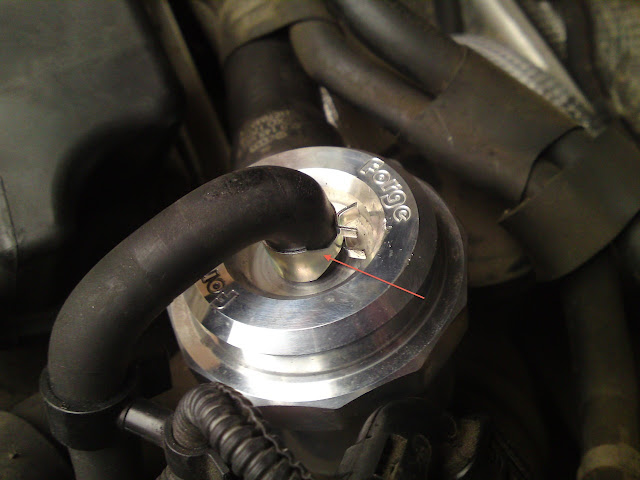The first of these cheap ancillary parts to be replaced has to be the diverter valve, also referred to as the dump valve.
The technical bit...
The diverter valve is vital in preventing compressor-stall when the the throttle plate is closed, due to high-pressure air getting trapped between the throttle and the compressor side of the turbo and sending a pressure wave back towards the compressor. This can cause the turbine to rapidly slow down or stall completely and puts severe stress on the compressor.
This situation can easily happen when changing gear while the turbo is under boost conditions, as most people will temporarily lift off the throttle then reapply it. If the turbo loses speed between gearchanges there will be a delay while it spins up again - better known as turbo lag.
The major problem with the standard plastic diverter valves is that they contain a diaphragm which can eventually perforate due to the high-pressure, high-temperature air they are continually exposed to. This causes a continuous loss of boost as high-pressure air is allowed to bleed away back into the intake, and this is why any enthusiast should change the original valve for a more robust unit.
Note...
Replacing the diverter valve is not strictly a performance modification and will not increase power output from standard form. The whole point is to change it for a more reliable (and serviceable) unit which will then allow the rest of the system to run as it was intended, free from any losses caused by high-pressure leaks. Having said that, if your diverter is leaking you will immediately feel the benefits from the new valve as it reclaims lost BHP.
Also note...
The alternative to a diverter valve (also referred to as a recirculating dump valve) is an atmospheric dump valve, the kind that gives that distinctive "pshhhhhhht!" sound when operating. These can cause various problems for the engine management system due to the fact that the ECU has measured the incoming volume/mass of air and calculates the amount of fuel to inject based on this. If air is suddenly removed by venting the excess out of the system, the engine will suddenly have a fuel-rich mixture which can trigger engine management warning lights and limp-home mode to kick in.
For a simple life, stick to the original diverter type valve.
What you will need...
A replacement diverter valve (obviously) - the Forge Motorsport DV007 is the valve of choice for many as it fits very well, is well made, is serviceable and has the backup of a company renowned for its excellent after-sales support. Another popular choice is the Bailey DV30.
A flat-head screwdriver, 4-5mm across.
A large cross-head screwdriver.
Jubilee clips, 2 large (genuine Jubilee "1A" types are ideal at 22-30mm range).
Either a small Jubilee clip (10-15mm range) or a fuel-hose type spring clip (Mikalor 14mm is perfect fit).
Long-nose pliers if you go for the spring clip option.
Step 1. Remove the main engine cover. Use the large cross-head screwdriver to turn the cover retaining clips (arrowed) through 90 degrees then lift the cover away and put it safe.
Step 2. Remove the original diverter valve. The valve is located near the air filter box (replacement valve fitted in the image for clarity)...
And here's the original item in all its glory...
Here's where you need the smaller flat-head screwdriver. Insert it into the single-use clips (arrowed) and keep turning the screwdriver until the clips have enough slack so they can be moved out of the way...
Once the clips are slackened pull the old valve out and put the new valve in, using the large Jubilee clips on the inlet and outlet. It will end up like this...
Here's where I chose to use the spring clip (fuel hose type) rather than a Jubilee clip (arrowed below). Access is a bit tight for even the smallest Jubilee clips and the spring clip looks fairly "factory original", not that anyone will ever know if you refit the engine cover...
 | ||
And now you don't...
Conclusion...
Replacing the diverter valve is an easy job and is a must for any enthusiast. My old valve definitely was leaking boost, which could be heard when the driver's windows was down. The turbo would spool up, hit a certain pitch and then drop down to a lower pitch. With the new valve the turbo hits a certain pitch and stays there. The midrange feels stronger and more flexible as a result, and the upgrade is money very well spent. Finally the replacement valve is just that, a high quality replacement and not a performance enhancing modification. With this in mind you needn't feel too guilty about not declaring it to your insurance company should you happen to forget...
DubSteve


